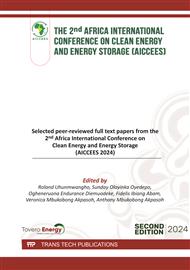p.43
p.53
p.65
p.85
p.121
p.141
p.155
p.165
p.175
The Impact of Protective Devices on Photovoltaic (PV) System Performance and Installation
Abstract:
The integration of photovoltaic systems into energy grids has been very common in recent times since more renewable forms of energy are sought after. Reliability and safety are among the most essential concerns that have to be considered for the deployment and operation of such systems. There have been some very conspicuous failures of protective devices in recent installations, leading to huge damage to solar equipment and an estimation of millions of Naira in repair and maintenance costs. The said incidents further underscore the need for technical competency in PV system installations as well as good-quality protective component acquisition. This study examines the critical role of protective devices in photovoltaic (PV) systems, focusing on their impact on system reliability, operational safety, and financial implications. A survey of industry professionals revealed that the major causes of device failures are overvoltage and poor-quality devices. Similarly, Circuit Breakers and Surge Protectors top the list of devices affected by failures. Critical system shutdowns take up 50% of the resultant consequences of failures, deteriorated performance, and safety hazards. Surprisingly, 65% of those who responded reported financial losses due to the failures, estimated at 45% between N100,000 and N500,000, while 15% had losses above N500,000. The study recommends high-quality protective devices be installed, installation and maintenance be standardized, and predictive maintenance/remote monitoring technologies be adopted to improve reliability and early fault detection. The long-term performance of devices in varying environmental conditions and the economic benefit of using durable, high-quality components are to be focused on further for research. These findings also put forward actionable suggestions to better ensure the PV system resilience for all stakeholders, thereby reducing their financial risks and ensuring the continued growth of the solar energy infrastructure in a reliable manner.
Info:
Periodical:
Pages:
121-137
Citation:
Online since:
February 2025
Keywords:
Price:
Сopyright:
© 2025 Trans Tech Publications Ltd. All Rights Reserved
Share:
Citation:


